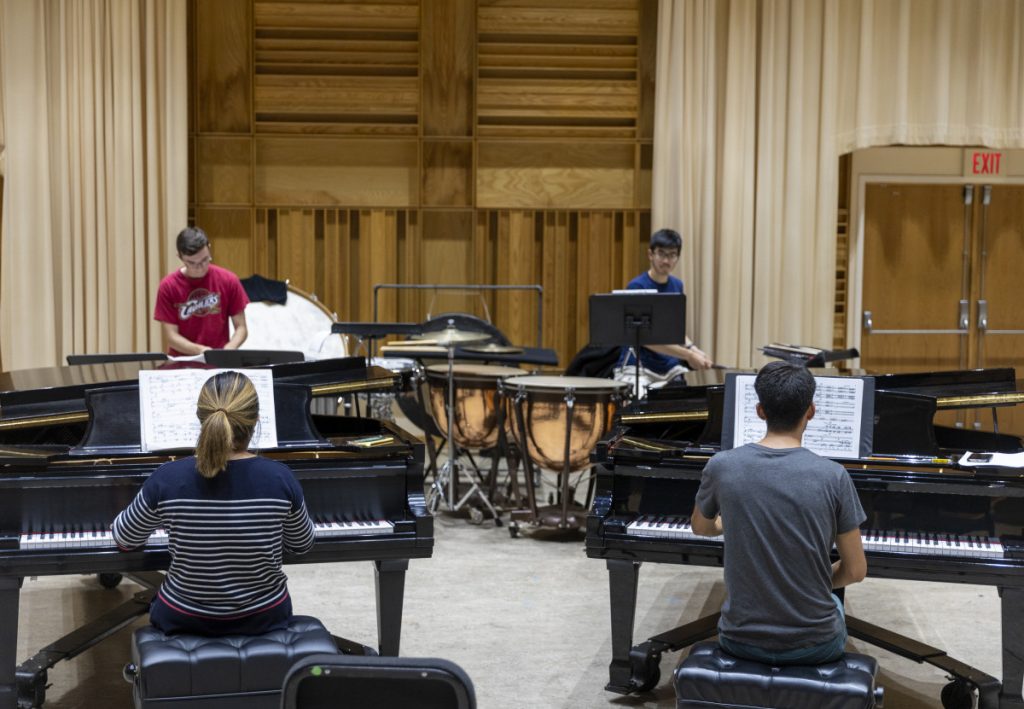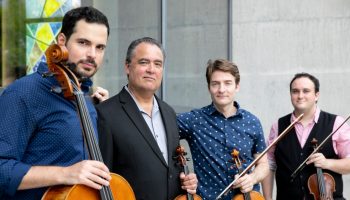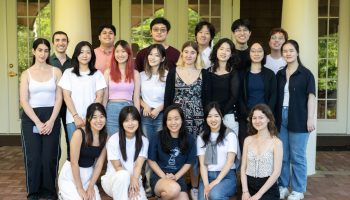NICHOLE JIANG – STAFF WRITER

As the School of Music season slowly winds down, members from the Music School Festival Orchestra and the Piano Program will come together to put on one of their only chamber recitals this season. The students will perform an eclectic program of both contemporary and classical works at 2:30 p.m. Sunday, July 18 in the Amphitheater.
Sunday’s recital highlights the talents of these musicians in a more intimate setting. Chamber music is something that MSFO students didn’t get to perform as much this season, but it’s something that is special to each musician.
“Chamber music is its own music-making,” said Timothy Muffitt, music director and conductor. “It requires a lot more knowledge of the score and requires developing interpersonal skills. Chamber music is a really important part of being a musician.”
There will only be one piece on Sunday’s program that will be performed with a conductor. This provides both challenges and opportunities for the students.
“Without a conductor, it gives us a lot of power and responsibility when putting it together,” said David Wang, percussionist. “It’s up to us to really know our own parts and each other’s parts. Becoming one unit is our end goal for chamber pieces. Playing off of each other is the most challenging, but also the most fun.”
This recital is also special as it gives the percussionists and wind musicians of the MSFO the chance to showcase their talents through a unique mix of pieces.
“It’s a program that provides a really nice balance to the repertoire, as there’s more music by living conductors,” Muffitt said. “Each work is dramatically different from the one before.”
The recital will open with Igor Stravinsky’s Octet for Wind Instruments. It will be followed by Andy Akiho’s LIgNEouS 5 for Marimba and String Quartet, Eric Nathan’s “Rothko Musings,” Francis Poulenc’s Suite Française and finish off with Béla Bartók’s Sonata for Two Pianos and Percussion.
The Stravinsky is the only piece being conducted, and will be done so under the baton of David Effron Conducting Fellow Joshua Hong. However, the musicians still make many of the decisions.
“We all have a common idea of what we want to do,” said Olivia Hamilton, clarinetist. “For chamber music we come up with our own ideas; the conductor doesn’t influence us completely. He’s just showing us so we remember during the performance.”
This piece features just winds and brass instruments, and allows each to shine through individually, while simultaneously blending together in a marriage of sound.
“Stravinsky really showcases the extreme highs and the extreme lows of each instrument,” Hamilton said. “There’s instances where I’m playing the highest note and then the lowest note not too far from each other. I might be playing one measure with the flute and one with the trombonist and it creates such a different tone color which I really appreciate.”
The Akiho piece is something the audience may have never heard before. Muffitt describes it as being “fabulously unique,” and said he was thrilled that the school can present it at Chautauqua.
The piece heavily features the marimba and many unorthodox ways of producing music.
“It’s very rhythmic and very percussion oriented,” Wang said. “There’s a lot of extended techniques from the marimba. Even the cello will have extended techniques like knocking on the instrument. It’s pretty unorthodox and nontraditional ways of playing instruments but that’s what makes it so unique.”
“Rothko Musings” is another contemporary piece that is unique sounding, as well. The composer, Eric Nathan, was inspired for this two-movement piece by Mark Rothko’s painting “White and Greens in Blue.” Nathan had always been inspired by Rothko’s paintings and would see them in various art museums.
However, it was this painting in particular that captivated him. Nathan described this experience as a “little window opening something up within” that he then could “engage, foster and nurture my personal expression that came up.”
This piece is also unique, as it only includes one bass trombone and two percussionists.
“I felt as if the instruments that I chose reflected the sonic worlds of the painting and the textures that I was trying to convey,” Nathan said.
The first movement of the piece represents what Nathan felt emotionally while he was engaging with the painting.
“About the Rothko painting, I would also say that there is a sense of stillness, but also an expressive inner life and mystery to it as well. My first movement has a stillness to it but there’s an expressive voice that gradually emerges and glows from within the clouds of percussion chords,” Nathan said. “There’s a meditative serenity to it.”
The second movement then represents the paint itself on the canvas. Nathan wanted to capture the essence of what was occurring in the painting.
“The second movement is the paint on the canvas, zooming and interacting (with) how the world is like on the surface of the painting. You don’t see the colors anymore, but an active interaction,” Nathan said, “finding more activity in the artwork, such as the brush strokes and the rectangular blocks Rothko is known for.”
The audience is able to experience this interaction through the music as Nathan describes this movement as “playful and dance-like.”
“It’s almost a little raucous, with some jazzy quality, as well,” Nathan said.
However, Nathan made a point to state that when listening to the piece, it’s up to the audience to interpret it how they want.
“I think that the music tells its own musical story that the audience can find their own meaning in,” Nathan said.
This piece was pivotal in Nathan’s career as a composer. It was his first piece that he composed as a master’s student at Indiana University’s Jacobs School of Music.
“It was a real departure for me, compositionally,” he said. “The nature of this instrumentation really forced me to rethink my language as a composer, and experiment in new ways. It was the beginning of a new trajectory as a composer.”
The Poulenc piece will feature oboes, bassoons, trumpets, trombones and one percussionist.
Finishing with the Bartók Sonata is a bold choice, as this piece is known to be quite a difficult piece to conquer.
“This is a rather iconic work,” Muffitt said. “It takes some really gifted musicians to pull it off, and we’re thrilled that we had people that could step up to the plate.”
The students are also excited to take on this challenge.
“I know that this piece is very difficult but it really attracts me at the same time,” said pianist Narae Lee. “This piece has a lot of tempo and rhythm changes. This is a very unique combination with the pianos and percussionists, and is a very good opportunity for us students.”
This piece showcases these talented individuals and gives them an opportunity to perform a well-known piece together at the end of their season.
“In a difficult year for chamber music, with very limited access to rehearsal space, we are delighted that two of our pianists will have the opportunity to play such an important cornerstone of 20th-century chamber music with percussionists from the MSFO,” said Nikki Melville, Piano Program co-chair.
Since this is one of the last performances the School of Music will present, the students are excited to show how much they have grown and how strong their bonds are.
“It’s been a spectacular experience. Even when we had performances it was for an empty crowd,” Wang said. “Seeing a big crowd out there supporting us makes each performance more meaningful. I’m especially looking forward to Sunday’s performance because it’s a lot of performing for us percussionists. I’m hoping to have a good crowd out there.”




